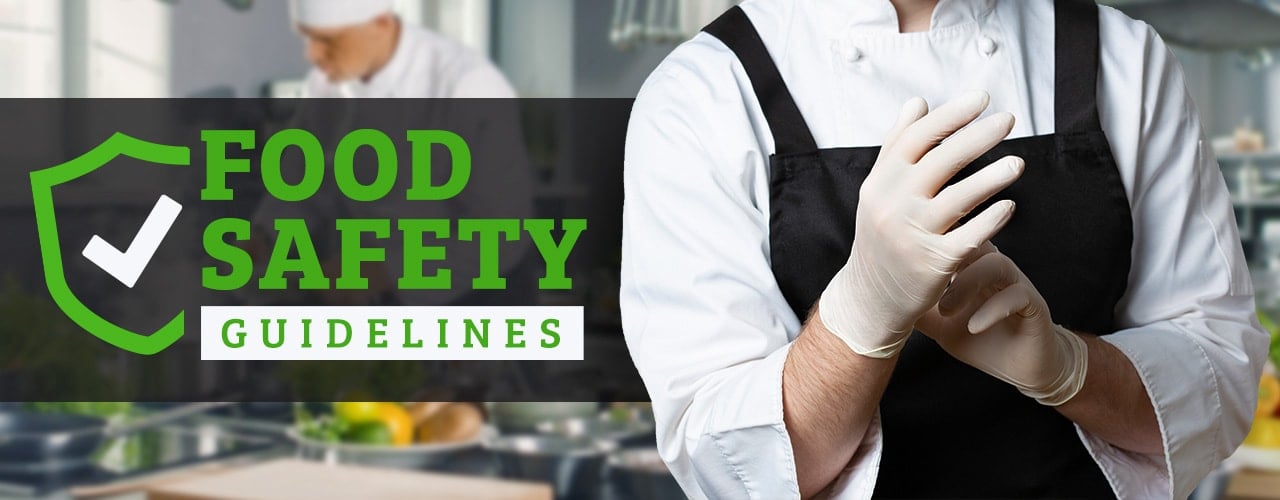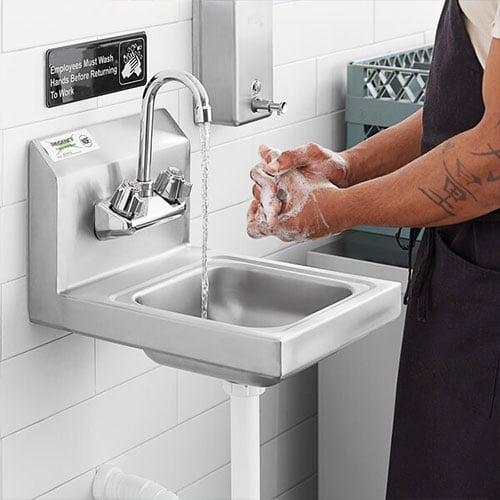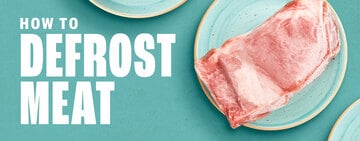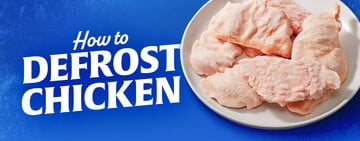
Food safety guidelines are put in place to keep customers safe and prevent the risk of a foodborne illness outbreak. Any operation that serves food should establish protocols that meet the legal requirements for safe food handling. In this guide, we'll outline the most important aspects of food safety to help you build an effective program for your business and pass your next health inspection.
Food Safety Guidelines for Restaurants
We’ll cover the most important aspects of a successful food safety program so you can prevent a foodborne illness outbreak and keep your guests safe.
1. Personal Hygiene

Poor hygiene is one of the most common causes of foodborne illness, but an outbreak can be prevented by establishing policies and following up with your staff regularly. Keep the following factors in mind when you create a hygiene program:
Handwashing
Washing hands takes mere minutes, and it’s a crucial step in preventing the spread of germs that cause foodborne illness. A foodservice handler who forgets to wash their hands one time could potentially contaminate food. That’s why it’s important to install handwashing sinks in proper locations and keep them stocked with plenty of hand soap and paper towels. Train your staff on the correct way to wash their hands and post reminders at each hand sink.
Hygiene Practices
Personal cleanliness plays a major role in food safety. Soiled uniforms, aprons, and even uncovered hair can become a source of contamination. A good hygiene policy should cover the following practices:
- Hair Restraints - Food handlers should wear clean hats or hair restraints (including beard restraints)
- Clean Work Uniforms - All uniforms and aprons should be laundered. Soiled uniforms and aprons should be stored away from food prep areas.
- Jewelry - Jewelry should be removed before handling food because it can harbor germs or accidentally fall into food. A plain wedding band is acceptable.
- Eating and Drinking - Employees should never eat or drink near food and food prep areas. Beverages should be placed in a cup secured with a lid and straw. Staff members should handle the beverage carefully and keep it away from food, utensils, and equipment.
Staff Illnesses
Any time an employee becomes ill, it poses a safety risk for your guests and staff. Take the proper precautions with any sickness, but be on the lookout for certain pathogens that are notorious for spreading foodborne illness in foodservice environments. Employees should notify a manager if they have contracted an illness from the following pathogens:
- Norovirus - very contagious and often spread through hand-to-food contact
- Shigella spp. - often spread by unwashed hands or contaminated water
- Nontyphoidal Salmonella - commonly linked to poultry, eggs, meat, and dairy
- E. coli - commonly linked to undercooked ground beef
- Hepatitis A - handwashing is the best defense because this pathogen is not destroyed by cooking
- Salmonella Typhi - commonly linked to ready-to-eat food
Handwashing and cooking foods to the correct internal temperature are two of the best defenses against these pathogens. Staff members experiencing vomiting, diarrhea, or jaundice should be excluded from working in your operation until they receive a written release from a doctor.
Disposable Glove Use
Wearing single-use gloves is an effective precaution but only when done properly. Hands must be washed before putting on gloves, and gloves should be changed at the appropriate times. Post reminders for your staff so they know when to change single-use gloves:
- After handling raw meat
- Before touching ready-to-eat food
- When gloves become dirty or torn
- Before starting a new task
- After 4 hours of continuous use
Back to Top
2. Proper Food Handling

Proper food handling starts when you receive a food shipment and continues until the food is served to your guests. Every step along the way requires strict controls and continuous monitoring. Foods that require special handling are called TCS foods (time-temperature control for safety). These foods provide a more hospitable environment for pathogens to grow, especially at certain temperatures. Throughout all the steps below, TCS food should be kept out of the temperature danger zone, the range from 41 to 135 degrees Fahrenheit.
Receiving and Handling
Train your kitchen staff to be food-safe at all times throughout receiving, prepping, and cooking.
- Receiving - Inspect your food shipments carefully and check temperatures. All TCS foods should be received at the right temperature and stored immediately. Frozen foods should be frozen solid on arrival. Ice crystals and water stains on the packaging are signs that the food may have thawed during transport. Reject any foods that do not meet temperature requirements or appear to have been time-temperature abused.
- Cross Contamination - Germs can be spread by hands, but also by contaminated foods, tools, and equipment. When raw foods like uncooked chicken come into contact with prep surfaces, pathogens can be left behind to contaminate other foods. Prevent cross-contamination by keeping foods separated, using color-coded kitchen tools, and cleaning and sanitizing equipment after use.
- Cooking Food Correctly - Cooking foods to the correct internal temperatures is an important safeguard against the spread of pathogens. Some pathogens are spread by unwashed hands, and some may already be present in foods like eggs and beef. To destroy these germs, foods need to be cooked to a safe minimum temperature and tested with a clean, reliable thermometer.
Holding and Storage
Foods should be kept at safe temperatures throughout holding and storage.
- Food Holding - Food holding is the practice of cooking foods ahead of time and holding them at a certain temperature. A soup that is made in the morning and stored in a soup warmer is being "hot-held". If the temperature of the soup falls in the danger zone, pathogens can grow to harmful levels. Any foods that are hot-held or cold-held must be kept at safe temperatures and monitored periodically to make sure they do not enter the temperature danger zone.
- Proper Cooling - Foods can also enter the temperature danger zone when they are not cooled correctly. If hot dishes are prepared ahead of time and placed into cold storage to be reheated later, they must be cooled using a two-step process. Food must be cooled from 135 degrees Fahrenheit to 70 degrees Fahrenheit within 2 hours. Then cooled from 70 degrees Fahrenheit to 41 degrees Fahrenheit within 4 hours. This prevents the foods from lingering too long in the temperature danger zone.
- Food Storage - The method you use to store foods affects food safety. Always think first in, first out (FIFO) when putting foods away in storage. Push newer foods to the back of the shelf, and keep the older foods in the front so they get used first. TCS foods should be placed on cold storage shelves in a certain order to prevent liquids from dripping on the foods below and causing a contamination issue. The correct storage order from top-to-bottom is ready-to-eat foods, seafood, whole cuts of beef and pork, ground meat and fish, and whole or ground poultry.
Back to Top
3. Cleaning and Sanitizing

It's a common misconception that cleaning and sanitizing are the same thing. They are two different methods, but both are crucial steps to maintaining a food-safe kitchen. Cleaning removes dirt and debris from a surface while sanitizing reduces pathogens on a surface.
How to Clean and Sanitize Food Contact Surfaces
Surfaces that don't come into contact with food only need to be cleaned and rinsed. But food-contact surfaces like prep tables, tools, and equipment must be cleaned and sanitized. Follow these steps to clean and sanitize correctly:
- Wipe the surface to remove any crumbs or food particles
- Wash the surface with an approved food-safe cleaning solution
- Rinse the surface with clean water
- Sanitize the surface with an approved sanitizing solution mix to the right concentration
- Let the surface air dry
To keep food-contact surfaces free of pathogens, cleaning and sanitizing must be performed at the appropriate times. Train your staff to sanitize surfaces when they complete a task or start prepping a different food. They should also stop and sanitize if they are interrupted in their task and after using the same surface for 4 continuous hours.
Cleaning and Sanitizing Equipment
Kitchen equipment is more challenging to clean and sanitize than a smooth surface like a prep table because there are moving parts. For the best sanitizing method, refer to the manual for each specific type of equipment. Follow our guidelines below for general equipment sanitizing:
- Make sure the equipment is powered off and unplugged
- Disassemble any removable parts
- Wash all parts by hand or run through the dishwasher
- Clean any food debris from equipment surfaces
- Wash the equipment with an approved cleaner, rinse, then sanitize
- Let parts and equipment air dry before reassembling
Dishwashing Guidelines
What other items in your restaurant come into contact with food? You'll need to establish a dishwashing program for all the cookware, utensils, and tableware you use daily. Flatware, dinnerware, and glassware can be run through a dishwasher, but larger items like cooking pots and pans must be cleaned and sanitized manually in a three-compartment sink.
- High Temp Dishwashers - These dishwashers use hot water to clean and sanitize dishes. To be effective at destroying germs, the water in the dishwasher must reach a temperature of 180 degrees Fahrenheit in the final rinse.
- Chemical Dishwashers - Unlike a high-temp machine, a chemical dishwasher relies on chemical sanitizers to eliminate pathogens.
- Three-Compartment Sinks - It's possible to clean and sanitize manually in a three-compartment sink, but only if the steps are performed correctly. Refer to our three-compartment sink guide to learn the best way to use this method.
Back to Top
4. Pest Control

No one wants to think about pests invading their restaurant. Unfortunately, ongoing prevention is required to keep your business pest-free. Unwanted critters can damage your facility, but the biggest threat from pests is their potential to spread diseases and foodborne illness. To create a successful pest control program for your restaurant, there are three components to keep in mind: deny access, deny food and shelter, and work with a licensed pest control professional. Learn how to enforce these pest control tips below:
Deny Access
Denying access to pests means preventing them from gaining entry to your building in the first place. Check all food deliveries carefully for potential hitchhikers and reject shipments with any signs of pest activity. Inspect your building to find any openings where pests can enter. Seal off cracks, install door sweeps, and keep windows and vents screened off. Use air curtains above doorways with outdoor access to deter airborne pests from entering.
Deny Food and Shelter
Remove the temptation that attracts pests to your building. Take out garbage periodically throughout the day, keep trash containers clean, and make sure dumpsters are closed securely. Any spills, crumbs, and food debris should be cleaned up immediately. It's crucial to clean beneath equipment and never leave food attractants out overnight when pests are more active. This includes the dining room and front-of-house! Always clean out crumb-catchers and sweep beneath booths and tables.
Work with a Licensed Pest Control Professional
If you've tried denying pests entry, food, and shelter but somehow they have found a way in, it's time to call a professional. Don't wait! As soon as you see any signs of a pest infestation, no matter how small, find a licensed pest control technician immediately. Do not attempt to set traps or put out poison yourself. A pest control professional will know exactly what to look for and how to handle each pest in the safest, most effective way.
5. Purchase from Approved Suppliers

You can do everything right and follow all the food safety guidelines available, but if the source of your food isn't reputable, you have a big problem on your hands. This is especially true for ready-to-eat foods like produce that don't get the benefit of high-heat cooking to destroy pathogens. Lettuce can become contaminated by agricultural run-off and absorb tainted water into the leaves. This type of contamination can't be removed by washing because the germs are inside the produce. This is why outbreaks from contaminated romaine lettuce have frequently made the headlines. The only way to prevent this type of occurrence is to buy produce (and all other foods) from an approved supplier.
So what exactly is an approved supplier, and how do you find one? Here are some tips:
- Never buy from roadside vendors, farmer's markets, or local farmers unless they are approved commercial suppliers.
- Choose a commercial supplier that meets the requirements of local, state, and federal laws.
- A reputable supplier should be able to provide inspection reports that cover all practices from receiving to staff training.
- Be especially picky when choosing suppliers of TCS foods.
- Even with a supplier you trust, you should still inspect every shipment carefully and reject anything suspicious.
Back to Top
6. Training and Monitoring

Once you've outlined a food safety program, you'll need to establish standard operating procedures to support your goals. Strict monitoring is required and your staff will need continuous training to uphold the SOPs you've created.
Standard Operating Procedures
First of all, what is an SOP? A standard operating procedure (SOP) is a fancy term for a written rule or guideline. Putting a procedure in writing is a way to hold your staff accountable for following the policies of your food safety program. SOPs also provide instructions that your team can follow even when a manager isn't present, which helps make your kitchen more efficient. When writing SOPs, keep the following things in mind:
- Who will perform the task
- What supplies are needed to perform the task
- Where will the task be performed
- When should the task be performed
- How will the task be performed
Training
Once you have established all SOPs in writing, you can begin to train your staff. Your efforts will be more successful if you think of training as an ongoing necessity, not a one-time obligation. New team members need to go through a training program when they are hired, and veteran employees always benefit from a refresher course. As you create a training module, utilize different methods like training videos, written instructions, demos, and role-playing exercises. Place visual aids like posters throughout your kitchen as helpful reminders.
Monitoring
The only way to be sure that your SOPs are being followed is to establish monitoring practices and quality control. Temperature checking is one of the most important examples of a monitoring procedure. Keep a written record that shows the date and time of the temp check, the temperature of the food, and the initials of the employee performing the check. The team member should also indicate if any corrective actions were needed.
Monitoring can also be as simple as watching your team members or appointing someone else to observe that SOPs are being followed. If you see a team member fail to wash their hands at the appropriate time, it's an opportunity to re-train that employee. Sometimes corrective actions may need to be taken if food safety is at risk. Make sure that you consistently monitor your food safety program to ensure its success.
There is a lot to cover with food safety, and one of the best ways to keep your team members educated is to require food handlers certification for all back-of-house employees. At least one certified team member should be on staff at all times. Follow our guidelines for general food safety, but refer to the requirements of your local regulatory authority to ensure compliance.





